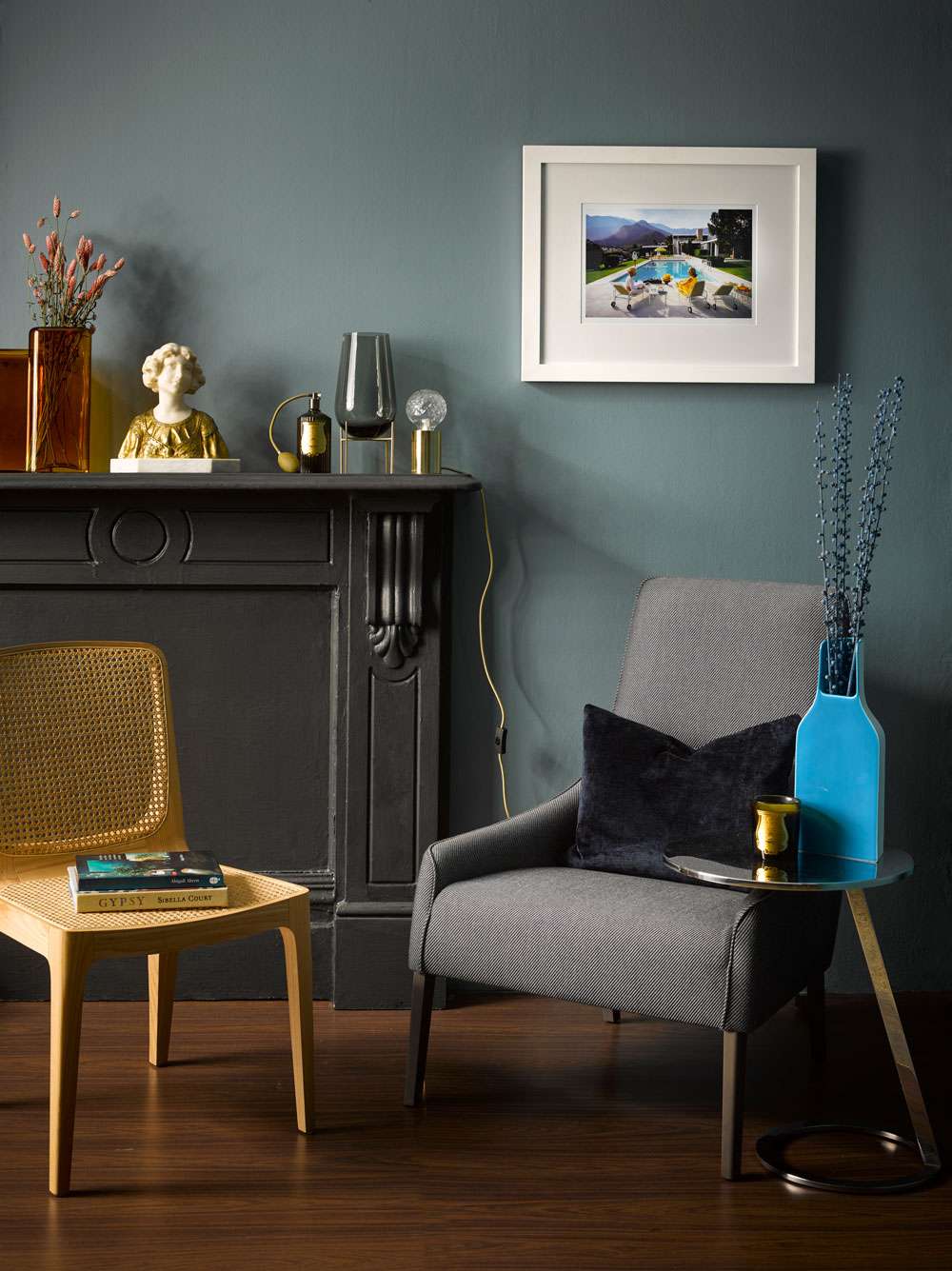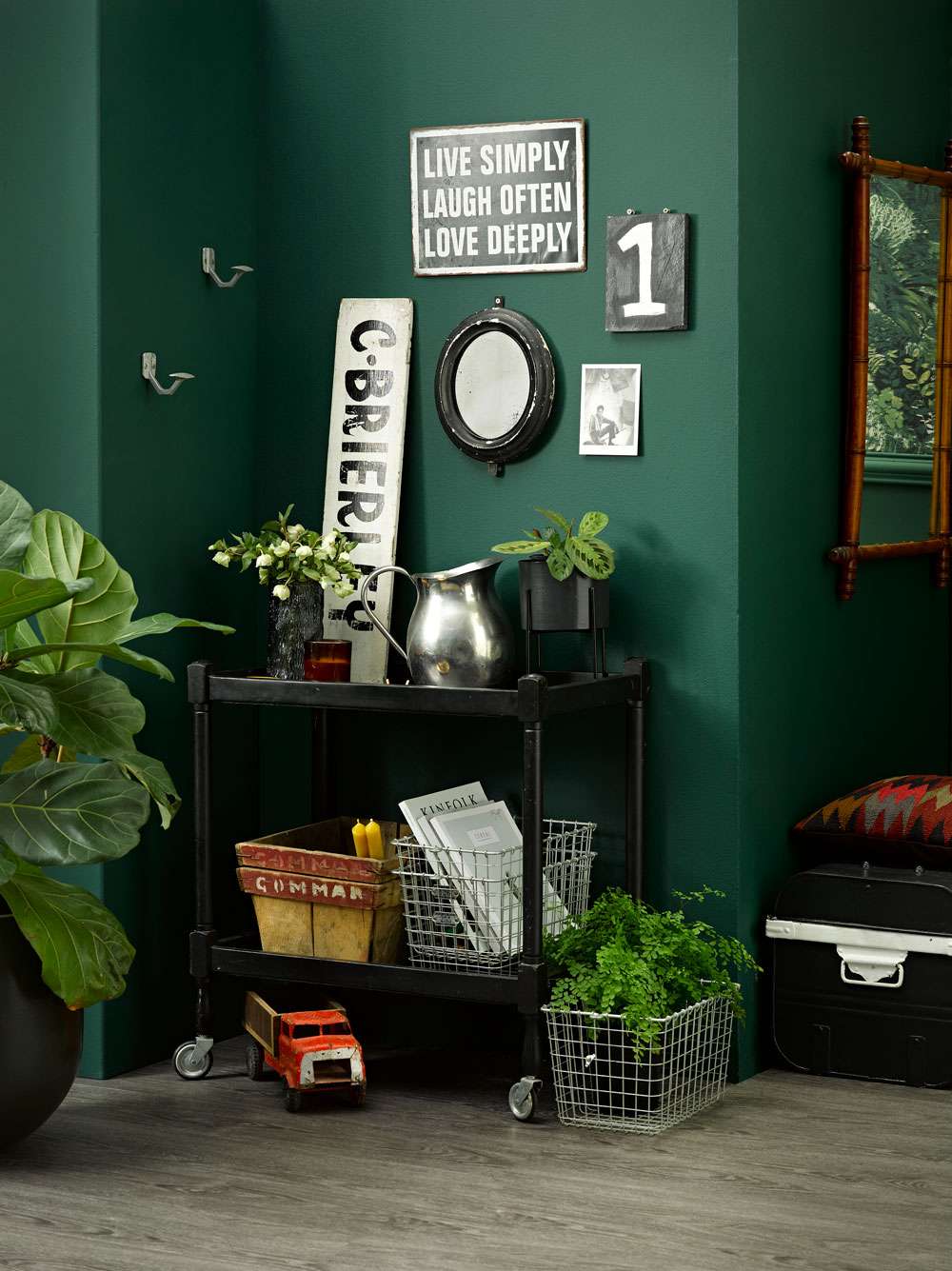Shops that sell interior décor have been looking increasingly more like museums or art galleries and have put a greater focus on locally made and bespoke products. Today’s decorators, too, are seeking out objects with soul, character and stories attached to them in order to lend their interior schemes more authenticity.
The nature of trends is that they’re often multipronged, blurring the boundaries the typically exist between often compartmentalised areas of our lives. While some may associate ideas like storytelling with, say, website design or Instagram, it makes sense that this trend has found its tie into home décor.

The mantel of afireplace is a natural space for displaying a curated collection. Wall inResene Blue Bayoux, fireplace in Resene Bastille, floor stained in ReseneColorwood Cedar timber stain. Project by Amber Armitage, image by Wendy Fenwick.
Start your property search
Stylist Kate Alexander believes the rise in creating these carefully curated collections is due to buyers getting sick of seeing the ‘same old same old’ from larger chains.
“The big shops are following the same trends and essentially selling the same things. Social media has severely shrunk the timeline between a trend being recognised and homeware brands producing their version of the trend. We’re rebelling by searching out products that have a story, items we can be proud to own.”
She also thinks it helps that the people who are making handmade items are more accessible now. “We meet them on social media and observe their creative journey. I’m excited this has become a trend because I’m a big believer in supporting artisans, they make our homes, and lives far more interesting and colourful,” says Kate.
A balance between minimalism and maximalism, a curated collection is generally comprised of an edited-down, manageable number of possessions. While it doesn’t need to be perfectly Instagrammable, there are a few easy design strategies you can put to work to help your collection look for cohesive.

Artist Greer Clayton used testpots in Resene Bubble N Squeak, Resene Triple Sea Fog, Resene Sea Fog, Resene Alabaster, Resene Half Dusted Blue, Resene Double Pravda, Resene Rivergum, Resene Artemis and Resene Quarter Baltic Sea to create this seemingly curated collection of artworks. Wall in Resene Sea Fog, shelf in Resene Alabaster, chair in Resene Rivergum, desk in Resene Artemis and vase (on shelf) in Resene Quarter Baltic Sea. Project by Greer Clayton, photo by Bryce Carleton.
“There is definitely no right or wrong way to do it, says Kate. “But it is harder than it looks to mix mass produced and artisan items together seamlessly."
She suggests starting with any mass produced items you own as the base of your display then show off your more unique items around them. “A one-off object deserves to be put on display so give it pride of place by lighting it well, placing it on top of a pile of books or a tray. Give it room to shine and don’t drown it out by surrounding it with too many other things.”
Repetition is one of the key tenements of interior design, a principle that can be followed by professions and layman alike. It’s accomplished by repeating shapes, forms, patterns, colours or themes within a space – and it works best when its employed in concert with another key design principle: the ‘rule of three’.
Luckily, you don’t always need to buy new things to get in on this trend. Upcycling something you already have with a lick of paint could be just the thing to make your collection of home décor items feel cohesive. Plus, employing this strategy is one of the simplest and most cost-effective ways to build upon a colour scheme.

Showcase a collection of favourite coffee table books or small artworks on lipped shelves, making it simple to remix your pieces regularly without the need to put any more holes in the wall. Walls in Resene Alabaster with a painted ‘bookcase’ wall feature in Resene Soulful, shelves in Resene Just Right, floor in Resene Colorwood Whitewash. Project by Amber Armitage, photo by Melanie Jenkins.
“Updating or upcycling your furniture with a new shade of Resene wood stain or freshening it up with your favourite new Resene paint colour is a great way to makeover what you have with little impact on the environment,” says stylist Amber Armitage.
If you are in need of an instant makeover and just want a change, before purchasing more things, consider what you can do with what you already have. Amber suggests reworking your displays using what you have hidden in storage. “Try using a trolley or sideboard and restyling it with vintage treasures that you might have tucked away.”
“And when considering your next purchase, don’t just think about new but think about adding cool vintage pieces to your collection. With so many great stores around that sell either beautiful mid-century furniture or vintage finds from far and wide it would be crazy to not consider these options. With so much history and craftmanship in these older pieces, they really add some magic to an interior space,” says Amber.

Walls painted in Resene Family Tree and floor stained in Resene Colorwood Tiri. Pot, trolley, small potted stand and trunk all painted in Resene Noir, with trim on trunk in Resene Alabaster. Project by Amber Armitage, image by Melanie Jenkins.
Second-hand and charity shops are a great place to find hidden treasures that you can breathe new life into with just a coat of paint. Keep it simple with a single Resene colour over an old set of drawers or give your creative side free reign by painted on patterns or incorporating unexpected colour combinations that add some individuality to a classic palette.
“Always be looking, and buy something if you like it,” Kate recommends. “It’s like you never find the right dress when you go shopping for a new outfit – you find it when you just happened to pop-in in to a shop you walked past because something in the window caught your eye.”
“Embrace it as a life-long approach rather than a trend. A home of curated objects cannot be created overnight. Work hard to decipher what is really you and what brings you pleasure to look at, buy when you travel, and enjoy the hunt – some of my favourite pieces are just that due to the story behind how I found them.”
If you have like-minded upcycling friends, consider starting a Facebook group to let each other know when you have furniture or decorative painted items you’re finished with and want to swap for something else. You’ll each come home with something new to you without having to spend money or send something that still has plenty of life in it off to the landfill. Remember, if it’s the wrong colour, you can always paint it.
Top tip: Make your own DIY artwork to complement or coordinate with an existing favourite. Or, make a whole set of artworks that go together as a collection using the same collection of Resene paint colours.
Try one of these colourful ideas for bringing your curated treasures the attention they deserve:
• Repurpose unused bed linen, curtains or clothing into cushion covers, placemats or even upholstered stool tops and chair bases.
• Use up your Resene testpot leftovers with some home-made artworks on canvas or card. A great way for the kids to get involved in decorating their own rooms. You can even re-use these for new artworks at a later date by repainting them all over again.
• A collection of old cake tins can double as great planters for succulents and cacti. Don’t use non-stick ones as they’ll need sanding. Then paint in your favourite Resene colours. Maybe try some on-theme desert shades.
For more colour, paint and wallpaper ideas and inspiration see the latest looks online www.resene.co.nz/latestlooks or visit your Resene ColorShop.
This content has been created in partnership with Resene.










